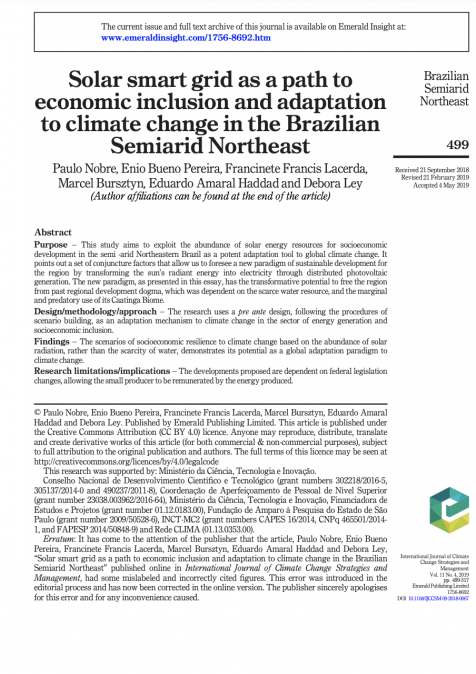Publications /
Paper in Academic Journals
Purpose
This study aims to exploit the abundance of solar energy resources for socioeconomic development in the semi -arid Northeastern Brazil as a potent adaptation tool to global climate change. It points out a set of conjuncture factors that allow us to foresee a new paradigm of sustainable development for the region by transforming the sun’s radiant energy into electricity through distributed photovoltaic generation. The new paradigm, as presented in this essay, has the transformative potential to free the region from past regional development dogma, which was dependent on the scarce water resource, and the marginal and predatory use of its Caatinga Biome.
Design/methodology/approach
The research uses a pre ante design, following the procedures of scenario building, as an adaptation mechanism to climate change in the sector of energy generation and socioeconomic inclusion.
Findings
The scenarios of socioeconomic resilience to climate change based on the abundance of solar radiation, rather than the scarcity of water, demonstrates its potential as a global adaptation paradigm to climate change.
Research limitations/implications
The developments proposed are dependent on federal legislation changes, allowing the small producer to be remunerated by the energy produced.
Practical implications
The proposed smart grid photovoltaic generation program increases the country's resiliency to the effect of droughts and climate change.
Social implications
As proposed, the program allows for the reversion of a pattern of long term poverty in semi-arid Northeast Brazil.
Originality/value
The exploitation of the characteristics of abundance of the semiarid climate, i.e. its very condition of semi-aridity with abundant solar radiation, is itself an advantage factor toward adaption to unforeseen drought events. Extensive previous research has focused on weighting and monitoring drought i.e. the paradigm of scarcity. The interplay between exploiting Northeast Brazil’s abundant factors and climate change adaptation, especially at the small farmer levels constitutes a discovery never before contemplated.


